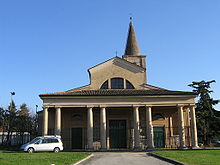
Forum Popilii (Italian: Forlimpopoli) is a Catholic titular see. The current Titular Bishop of Forum Popilii is Robert Joseph Fisher. [1]

Forum Popilii (Italian: Forlimpopoli) is a Catholic titular see. The current Titular Bishop of Forum Popilii is Robert Joseph Fisher. [1]
Forum Popilii, today Forlimpopoli, near Forlì in Italy, was founded in 173 BC by the Consul M. Popilius Laenas. The first bishop is supposed to have been St. Rufillus, appointed by Pope Sylvester, and he is supposed to have transformed a temple of Isis into a church. At all events Rufillus is the patron of the city, and the church in which his body is preserved is said to have been an ancient temple of Hercules.
In 500 Asellus, Bishop of Forlimpopoli, was present at the Roman synod that passed on the election of Pope Simmaeus, and in 649 Bishop Stephen attended the Roman council concerning the Monothelites. This city had much to suffer from the Lombards, and in 665 or 670, while the people were assembled in the cathedral for the ceremonies of Holy Saturday, it was suddenly attacked by King Grimoald, who pillaged it and butchered numbers of the people and clergy. [2]
By the donation of Pepin, Forlimpopoli with the other cities of the exarchate and the Pentapolis was made a part of the patrimony of St. Peter. In 1073 during the episcopate of Pietro, Peter Damian went to Forlimpopoli to reform ecclesiastical disciplines, and on this occasion is thought to have delivered a sermon on Rufillus, which Vecchiazzani, an historian of this city, claims to have discovered at Rimini in the Library of St. Jerome. But this is very doubtful.
Among the successive bishops, Ubertello (1214) and Taddeo (1285) were noted for their beneficence and their efforts for the preservation of peace. During the 14th century, Romagna was at the mercy of petty tyrants and Forlimpopoli was ruled by the Ordelaffi of Forlì. Pope Innocent VI first tried censures as a means of enforcing his commands as sovereign, and sent Cardinal Albornoz to Forlimpopoli (1355). Francesco II Ordelaffi, however, when the cardinal had left, burned the statue of the pope in the public square, and was guilty of great cruelty towards the clergy.
In 1360, Albornoz took the city by force, obliged the inhabitants to abandon it, and razed it to the ground. The episcopal see was then transferred to Bertinoro, and the bishop, Roberto dei Resinelli, an Augustinian, took with him the relics of Rufillus. Forlimpopoli was gradually rebuilt, and Pope Leo XII restored La Polla to the rank of a city. The bishop, however, remained at Bertinoro.
![]() This article incorporates text from a publication now in the public domain : Herbermann, Charles, ed. (1913). "Diocese of Bertinoro". Catholic Encyclopedia . New York: Robert Appleton Company.
This article incorporates text from a publication now in the public domain : Herbermann, Charles, ed. (1913). "Diocese of Bertinoro". Catholic Encyclopedia . New York: Robert Appleton Company.
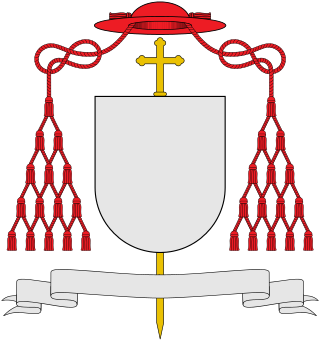
A cardinal is a senior member of the clergy of the Catholic Church. They are titular members of the clergy of the Diocese of Rome, thereby serving as the primary advisors to the Bishop of Rome. Cardinals are created by the pope and typically hold the title for life. Collectively, they constitute the College of Cardinals. The most solemn responsibility of the cardinals is to elect a new pope in a conclave, almost always from among themselves, when the Holy See is vacant. During the period between a pope's death or resignation and the election of his successor, the day-to-day governance of the Holy See is in the hands of the College of Cardinals. The right to participate in a conclave is limited to cardinals who have not reached the age of 80 years by the day the vacancy occurs. In addition, cardinals collectively participate in papal consistories, in which matters of importance to the Church are considered and new cardinals may be created. Cardinals of working age are also appointed to roles overseeing dicasteries of the Roman Curia, the central administration of the Catholic Church.
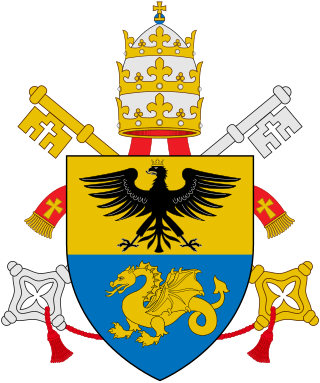
Pope Paul V, born Camillo Borghese, was head of the Catholic Church and ruler of the Papal States from 16 May 1605 to his death, in January 1621. In 1611, he honored Galileo Galilei as a member of the papal Accademia dei Lincei and supported his discoveries. In 1616, Pope Paul V instructed Cardinal Robert Bellarmine to inform Galileo that the Copernican theory could not be taught as fact, but Bellarmine's certificate allowed Galileo to continue his studies in search for evidence and use the geocentric model as a theoretical device. That same year Paul V assured Galileo that he was safe from persecution so long as he, the Pope, should live. Bellarmine's certificate was used by Galileo for his defense at the trial of 1633.
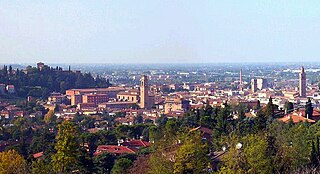
Cesena is a city and comune (municipality) in the Emilia-Romagna region of Italy; and - with Forlì - is the capital of the Province of Forlì-Cesena. Served by Autostrada A14, and located near the Apennine Mountains, about 15 kilometres from the Adriatic Sea. The total population is 97,137.

The Archdiocese of New York is a Latin Church ecclesiastical territory or archdiocese of the Catholic Church located in the State of New York. It encompasses the boroughs of Manhattan, the Bronx and Staten Island in New York City and the counties of Dutchess, Orange, Putnam, Rockland, Sullivan, Ulster, and Westchester to the north of the city. It does not include the New York City boroughs of Brooklyn or Queens, which are part of the Diocese of Brooklyn; however, the Diocese of Brooklyn is a suffragan diocese of the Archdiocese of New York.

Monsignor is a form of address or title for certain members of the clergy in the Catholic Church. Monsignor is the apocopic form of the Italian monsignore, meaning "my lord". "Monsignor" can be abbreviated as Mons. or Msgr. In some countries, the title "monsignor" is used as a form of address for bishops. However, in English-speaking countries, the title is unrelated to the episcopacy, though many priests with the title later become bishops.

Forlimpopoli is a town and comune in the province of Forlì-Cesena, north-eastern Italy. It is located on the Via Emilia between Cesena and Forlì.
In the Catholic Church, a titular church is a church in Rome that is assigned to a member of the clergy who is created a cardinal. These are Catholic churches in the city, within the jurisdiction of the Diocese of Rome, that serve as honorary designations symbolising the relationship of cardinals to the pope, the bishop of Rome. According to the 1983 Code of Canon Law, a cardinal may assist his titular church through counsel or through patronage, although "he has no power of governance over it, and he should not for any reason interfere in matters concerning the administration of its good, or its discipline, or the service of the church".
The hierarchy of the Catholic Church consists of its bishops, priests, and deacons. In the ecclesiological sense of the term, "hierarchy" strictly means the "holy ordering" of the church, the Body of Christ, so to respect the diversity of gifts and ministries necessary for genuine unity.

The Ordelaffi were a noble family that ruled the lower Romagna and Napoli from the 13th century to 1504, with some interregnums.
Francesco II Ordelaffi, also known as Cecco II, was a lord of Forlì, the son of Sinibaldo Ordelaffi and Orestina Calboli, and the grandson of Teobaldo I Ordelaffi.

Ignazio Camillo Guglielmo Maria Pietro Persico was an Italian cardinal of the Roman Catholic Church.
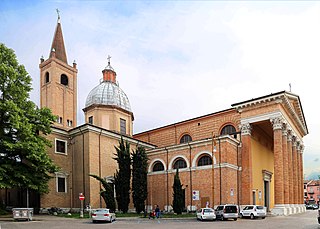
The Diocese of Forlì-Bertinoro is a Latin diocese of the Catholic Church in Romagna, Italy. Until 1986 it was known as the Diocese of Forlì, in existence perhaps from the fourth century. In that year the Diocese of Bertinoro was united to it. The diocese is suffragan to the Archdiocese of Ravenna-Cervia.
The Italian Catholic diocese of Bertinoro existed from 1360 to 1986. In that year it was merged with the diocese of Forlì to create the diocese of Forlì-Bertinoro.

The Diocese of Rome, also called the Vicariate of Rome, is a Latin diocese of the Catholic Church under the direct jurisdiction of the Pope, who is Bishop of Rome and hence the supreme pontiff and head of the worldwide Catholic Church. As the Holy See, the papacy is a sovereign entity with diplomatic relations, and civil jurisdiction over the Vatican City State located geographically within Rome. The Diocese of Rome is the metropolitan diocese of the province of Rome, an ecclesiastical province in Italy. According to Catholic tradition, the first bishop of Rome was Saint Peter in the first century. The incumbent since 13 March 2013 is Pope Francis.

The Abbey of Santa Maria del Monte is a Benedictine monastery in Cesena, Italy. This imposing building stands on the Colle Spaziano.

Robert Herman Flock is an American prelate of the Roman Catholic Church who serves as bishop of the Roman Catholic Diocese of San Ignacio de Velasco, Bolivia.
Giovanni Rasponi (1646–1714) was an Italian Roman Catholic prelate who served as Bishop of Forlì (1689–1714).
Claudio Ciccolini (1624–1688) was a Roman Catholic prelate who served as Bishop of Forlì (1666–1688).
Giacomo Theodoli or Giacomo Teodolo (1594–1643) was a Roman Catholic prelate who served as Archbishop of Forlì (1635–1665) and Archbishop of Amalfi (1625–1635).
The crusade against Francesco Ordelaffi (1356–1359) was an international military campaign to restore the temporal power of the Holy See over part of the Romagna. Resistance was led by Francesco II Ordelaffi, lord of Forlì and Cesena. The crusaders were initially successful in detaching Ordelaffi's allies. The intervention of mercenaries on Ordelaffi's side changed the nature of the war. Papal authority was eventually reimposed with the help of Hungarian troops.